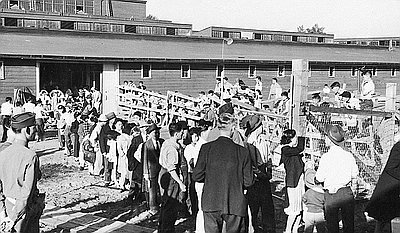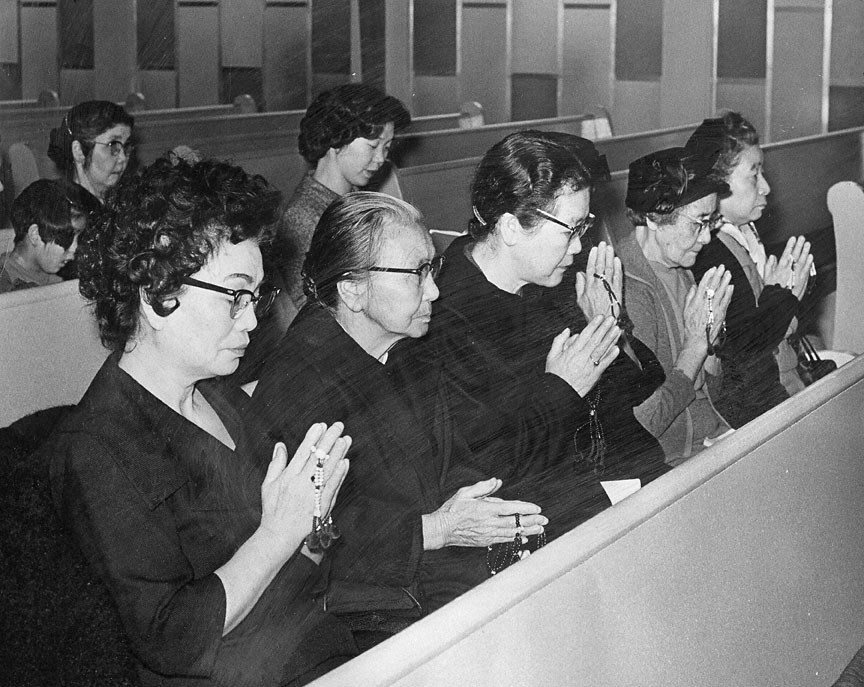- Catalog No. —
- OHS SIF 584-D
- Date —
- November 25, 1963
- Era —
- 1950-1980 (New Economy, Civil Rights, and Environmentalism)
- Themes —
- Race, Ethnicity, and Nationality, Religion, Women
- Credits —
- Oregon Historical Society
- Regions —
- Portland Metropolitan
- Author —
- Oregon Journal Collection
Women Pray at Nichiren Buddhist Church, 1963
This photograph was published in the Oregon Journal on November 25, 1963. It shows a group of women praying at Portland’s Nichiren Buddhist Church during a memorial service for President John F. Kennedy, who had been assassinated three days earlier.
Nichiren Buddhism is a school of Japanese Buddhism that is based on the teachings of Nichiren, a monk who lived in Japan during the thirteenth century. It is best known for its focus on the Saddharmapundarīka-sūtra (Lotus Sutra), one of the most influential texts in the Mahayana Buddhist canon. The caption that accompanied the photograph above mentions that the service held for President Kennedy centered on this sutra.
Buddhism came to Oregon in the nineteenth century with the first immigrants from China and Japan. Chinese immigrants established numerous temples, often referred to as “joss houses,” throughout the state during the latter half of the nineteenth century. While Chinese joss houses often had statues of Buddhist deities, they were not considered Buddhist churches. Japanese immigrants established the first Buddhist church in Oregon, the Portland Buddhist Church, in 1903 under the leadership of Shozui Wakabayashi, a native of Toyama, Japan. The church, a branch of the Jodo Shinshu (Pure Land school), built their first permanent building in 1910, by which time they had over five hundred members. Wakabayashi also organized the Buddhist Women’s Organization, a Dharma school (similar to a Christian Sunday school), and the first Japanese language school in Portland.
In 1930 Ryushin Okihara, a Japanese American minister from Seattle, helped establish Portland’s first Nichiren church. Two years later the members of the Nichiren Buddhist Church built a permanent building in north Portland. During World War II most of the members of the church were interned at the Minidoka Relocation Center in southern Idaho. The church’s minister, Yohaku Arakawa, continued to hold services in the camp for the duration of their internment, which lasted until 1945.
In 1958 the City of Portland condemned the Nichiren Buddhist Church’s building in order to build Memorial Coliseum. They relocated temporarily to a former pool hall in northwest Portland while they searched for a location in which to construct a new church. They decided on a location in southeast Portland near the corner of 20th and Yamhill, where the photograph above was taken. The Nichiren Buddhist Church is still active at this location, though they are now known as the Nichiren Buddhist Temple of Portland.
Further Reading:
Ouchida, Jack, et al., eds. A History of Eighty Years of the Oregon Buddhist Church, 1903-1983. Portland, Oreg., 1983.
Yasui, Barbara. “The Nikkei in Oregon, 1834-1940.” Oregon Historical Quarterly 76, 1975: 225-57.
Written by Cain Allen, © Oregon Historical Society, 2006.
Related Historical Records
-
Japanese Evacuees, Portland Assembly Center
In May 1942, Portland-area Japanese and Japanese Americans—both Issei (first generation) and Nisei (second generation) —were evacuated to hastily constructed temporary living quarters in the Pacific International Livestock …

-
Japanese Forced Removal and Incarceration
Although many have described United States’ involvement in World War II as the “good war,” the conflict also produced one of the most notable violations of civil rights …
